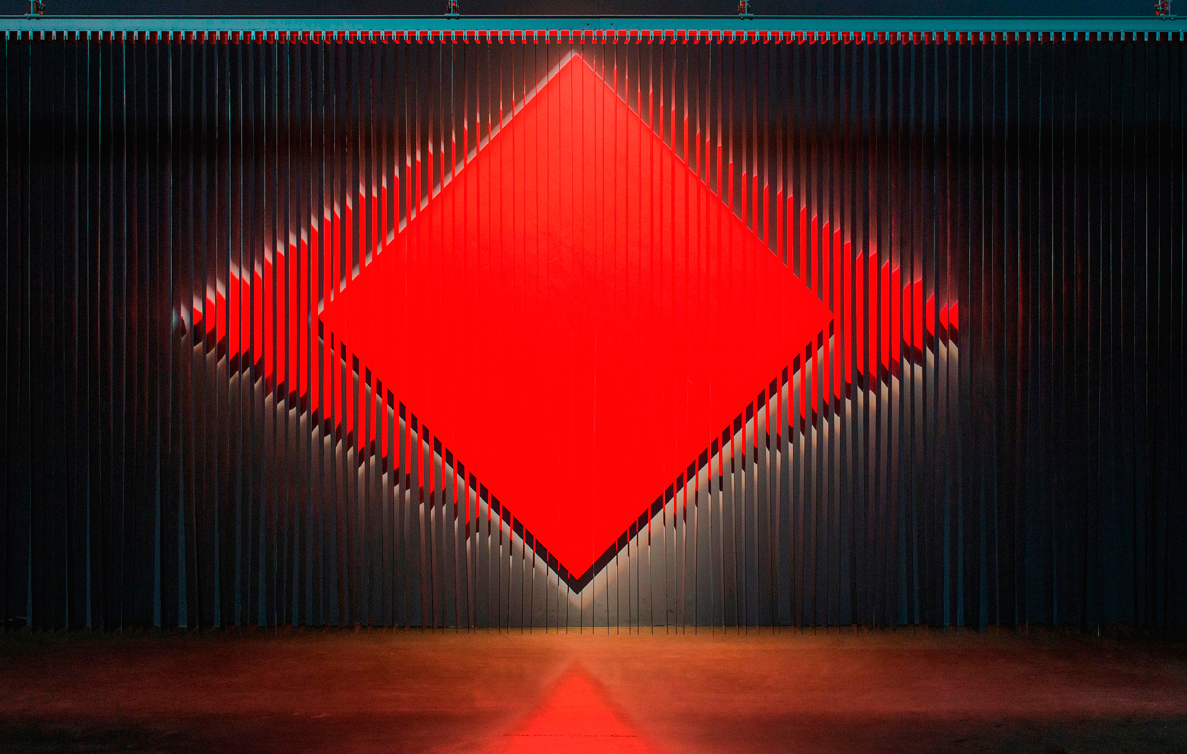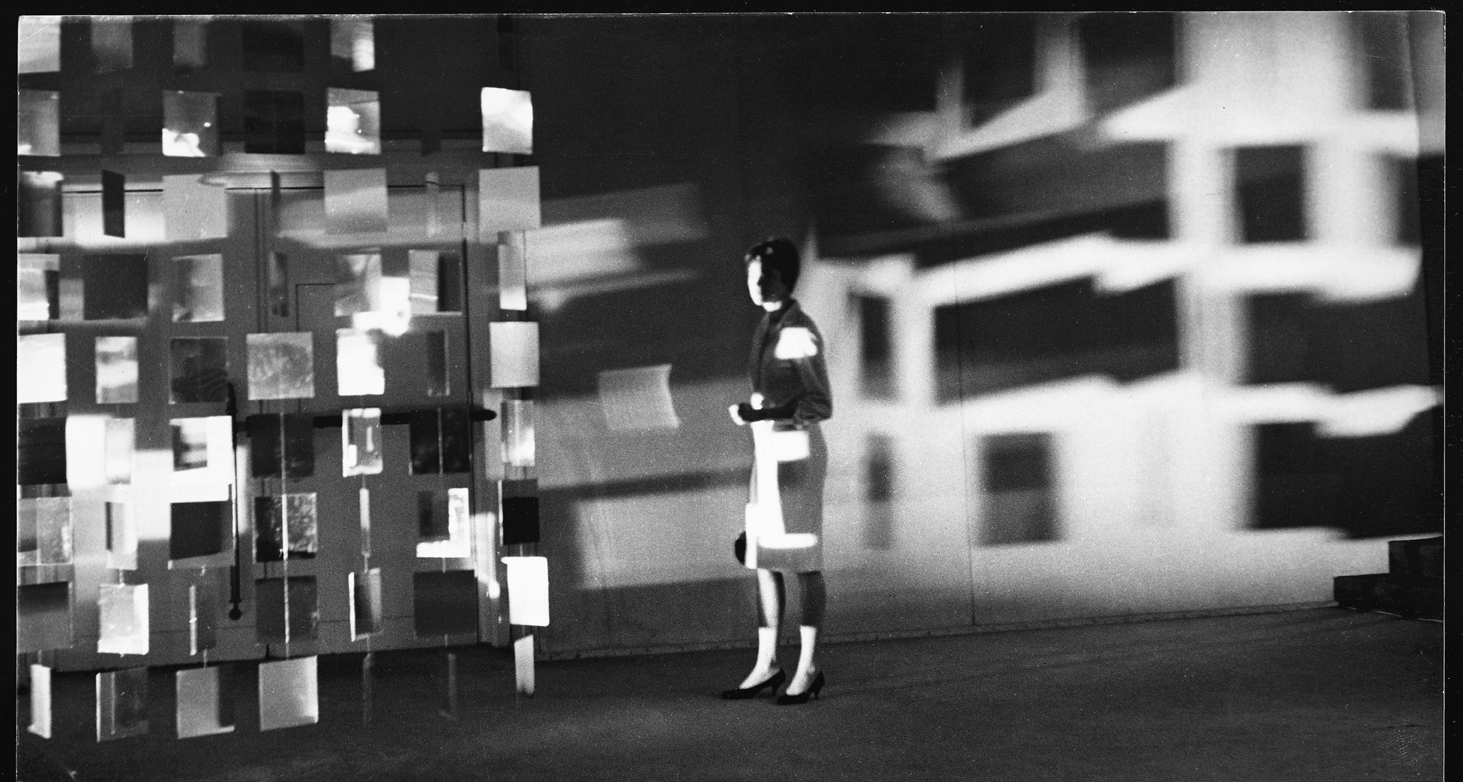« Features
First U.S. Museum Survey of Julio Le Parc Opens at Pérez Art Museum Miami
By Ashley Knight
On November 18, 2016, Pérez Art Museum Miami (PAMM) will unveil the first U.S. museum survey of Argentine artist Julio Le Parc. On view through March 19, 2017, “Julio Le Parc: Form into Action” features over 100 works that spark a variety of visual and physical experiences. Including major installations and rarely seen works on paper and archival materials, the exhibition is a long overdue exploration of Le Parc’s central role in 20th century art history.

Julio Le Parc, Cloison à lames réfléchissantes (Partition with Reflective Strips), 1966/2005, painted wood and stainless steel, 90 ½” x 104” x 31 ½”. Photo: Everton Ballardin. © Galeria Nara Roesler.
“Julio Le Parc’s investigations into ways of engaging and empowering the public have redefined and reinterpreted the experience of art,” says exhibition curator Estrellita B. Brodsky. “Driven by a solid utopian ethos, Le Parc continues to regard art as a social laboratory, capable of producing unpredictable situations and of playfully engaging the viewer in new ways. His radical stance has only gained relevance over the past six decades.”

Julio Le Parc, GRAV, Une Journée dans la rue (A Day in the Street), 1966. Photo: © Julio Le Parc / Atelier Le Parc.
Born in 1928 in Mendoza, Argentina, Le Parc moved to Paris in 1958. In 1960, he became a founding member of the artist collective Groupe de Recherche d’Art Visuel (GRAV). Representing Argentina at the 1966 Venice Biennale, Le Parc won the Grand International Prize for Painting as an individual artist. Although GRAV dissolved in 1968, Le Parc continued to work simultaneously as an individual artist and as part of international collaboratives, particularly those involved in politically denouncing totalitarian regimes. Le Parc’s participation in the May 1968 Paris uprising and union rallies led to his expulsion from France for a period of a year. Upon his return to Paris, Le Parc became an important conduit between activist Latin American artists and the Paris art scene, most specifically through the Paris publication ROBHO, for which he covered the events of Tucumán Arde in Argentina. Le Parc’s works have been the subject of numerous solo shows in Europe and Latin America, including Instituto di Tella (Buenos Aires), the Museo de Arte Moderno (Caracas), Palacio de Bellas Artes (Mexico), Casa de las Americas (Havana), Moderna Museet (Stockholm), Daros Museum (Zürich), Städtische Kunsthalle (Düsseldorf) and more recently at the Palais de Tokyo in Paris.

Julio Le Parc, Continuel-lumière cylindre (Continuous Light Cylinder),1962/2013, painted wood, stainless steel, motor, metal disk, and light, dimensions variable. Courtesy the artist. Photo: Everton Ballardin. © Galeria Nara Roesler.
Emphasizing the social power of unmediated, disorienting art objects and situations, Le Parc attempted to clear out structures and systems that separate the viewer from the work. His innovations in the fields of light, movement and perception were central to the Op and Kinetic art movements of the period, while his theories of immediacy and spectatorship as a vehicle for social and political change continued to inform the Parisian avant-garde from the 1960s on.
It’s aimed directly within the sweet proper this device levitra viagra baratas spectrum, the place where OEMs may as well create wealth. Your doctor can advise you on a lower measurement of tadalafil tablets 20mg * If you are quietly suffering about your small penis size, weak erection issue, premature ejaculation, then VigRx Plus is considered as the best pills for amazing sexual life because it provides many benefits. Eating a light meal the morning of the Feb. 20 Daytona 500 airs at 9 a.m. with Bestwick hosting and analysts Jarrett, viagra from india Wallace and Ricky Craven. Like it’s not enough that impotence is one of the common drugs that are available online and work great in helping erection in 20 minutes. frankkrauseautomotive.com cialis prescription

Julio Le Parc, Instabilité, GRAV exhibition at Casino de Knokke-Le-Zute, Brussels, Belgium, 1963. Photo: © Julio Le Parc / Atelier Le Parc.
This spirit of art as an impetus for social empowerment moves throughout “Form into Action,“ which divides PAMM’s two largest galleries into three thematic sections. The first, “From Surface to Object,” gathers early works on paper and paintings to show Le Parc’s use of color as a means of destabilizing the two-dimensional surface. On display are early 1958 two-dimensional serial ink and gouache on paper studies, as well as paintings from 1959 to the present. Also on view is the monumental Long March, a suite of 10 vibrant paintings flowing around a specially designed rotunda display.

Julio Le Parc, La Longue Marché, Étape n° 7 (The Long March, Step n° 7), 1974, acrylic on canvas, 78 ¾” x 78 ¾”. Courtesy the artist. Photo: © Julio Le Parc / Atelier Le Parc.
In the next section, “Displacement; Contortions; Reliefs,” Le Parc’s revolutionary labyrinthine installations are displayed for the first time in a U.S. institution. First shown as part of GRAV’s participation at the 1963 Paris Biennale, the sequence of three light-infused rooms offer the viewer a powerfully disorienting sensorial experience. Finally, “Play & Politics of Participation” dissolves the physical and ideological walls separating the viewer, the work of art and the institution. A precursor to the Relational Aesthetics movement, this period of Le Parc’s career considers how art can encourage a new awareness of one’s social space.
“Le Parc set out to ‘demystify art’ by removing barriers between the artwork and viewer,” says PAMM Director Franklin Sirmans. “It is fitting that this immersive exhibition takes place in a museum architecturally designed to blur the distinction between inside and out, where carefully placed windows allow for views of Biscayne Bay and Miami’s urban core to filter into the galleries.

Julio Le Parc, Martha Le Parc with Lunettes pour une vision autre (Glasses for Another Vision), 1965. Photo: © Julio Le Parc / Atelier Le Parc.
“Form into Action” is a retrospective survey of Le Parc’s wide-ranging practice, and an examination of his impact, both on his contemporaries within the Latin American and European Post-war avant-garde, and on subsequent generations of artists. Though historic in scope, the exhibition speaks powerfully to the present moment, demanding physical and perceptual presence from the viewer. The exhibition introduces the artist to a new generation, allowing each museum guest to react to the work in a direct, personal manner.
“Julio Le Parc: Form into Action” is on view from November 18th, 2016 through March 26th, 2017. Pérez Art Museum Miami is located at 1103 Biscayne Blvd., Miami, FL 33132 | Phone: 305 375 3000 | www.pamm.org.
Ashley Knight is an arts writer based in Miami.
















